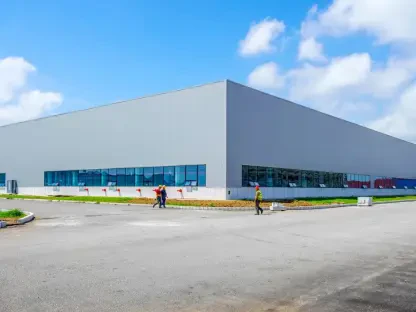The substantial growth trajectory of the Warehouse Management System (WMS) market, predicted to reach $13.53 billion by 2032, is a testament to its increasing relevance in today’s complex supply chains. With a compound annual growth rate (CAGR) of 16.23%, this market’s expansion is fueled by the rising complexity of supply chains and the rapid growth of e-commerce, particularly in the United States. As businesses strive for better operational efficiency and inventory management, the adoption of sophisticated WMS solutions is becoming imperative.
Driving Factors Behind WMS Market Growth
Surge in E-commerce and Online Shopping
Online shopping has witnessed substantial growth, with e-commerce constituting around 20% of total retail sales in the U.S. in 2023. Consumers prefer the convenience, competitive pricing, and quicker delivery options offered by e-commerce platforms. The U.S. e-commerce revenue reaching approximately USD 1.06 trillion, with mobile commerce accounting for over 40% of total transactions, underscores the need for robust inventory management systems. WMS solutions provide real-time visibility into inventory levels and order status, reducing human errors and optimizing stock levels.
With the rise in e-commerce, the demand for efficient logistics and inventory handling has never been more critical. This surge has necessitated the implementation of WMS solutions to meet the needs of ever-increasing consumer demands. Consumers expect rapid, accurate, and reliable service, and businesses are under pressure to streamline their operations to stay competitive. WMS solutions allow for the automation of many manual processes, decreasing the chance of errors and significantly speeding up operations. This not only enhances customer satisfaction but also helps companies to maintain better control of their stock, reducing excess inventory costs.
Complexity in Supply Chain Management
The increasing complexity of supply chains, driven by globalization and diverse consumer demands, necessitates advanced WMS solutions. Businesses are integrating these systems to enhance their operational efficiency and maintain a competitive advantage. Sophisticated WMS solutions streamline processes, from receiving and storing goods to picking and shipping orders, ensuring smooth operations and minimizing costs.
The intricacies involved in today’s supply chains require a level of precision and coordination that traditional methods cannot provide. Advanced WMS not only manage the end-to-end process within warehouses but also offer integration with other supply chain technologies such as transportation management and order fulfillment systems. This holistic approach allows companies to trace products from point of origin to the final customer, ensuring transparency and accountability at each stage. The insights gained from such integrated systems enable proactive decision-making and foster adaptability in a rapidly changing market landscape.
Industry-Specific Applications of WMS
Healthcare Sector
In the healthcare industry, where patient safety and compliance with regulations are paramount, accurate inventory management is critical. WMS solutions help track medical supplies and medications, preventing expiration or loss and ensuring compliance with healthcare regulations. These systems enhance operational efficiency, allowing healthcare providers to focus on delivering quality patient care.
Given the critical nature of healthcare services, efficient inventory management is not just a matter of cost savings but can be a literal lifesaver. WMS ensures that hospitals and clinics have the necessary supplies exactly when needed, minimizing wastage and avoiding shortages. This precision is particularly vital in managing perishable medical supplies and controlled substances, which require strict adherence to regulatory standards. Moreover, these systems make it easier to conduct audits and manage recalls, thereby enhancing overall healthcare quality.
Automotive and Manufacturing Industries
WMS solutions are essential in the automotive and manufacturing industries for managing complex inventories and production processes. By integrating these systems, businesses can track parts and materials accurately, reduce wastage, and ensure timely production. This results in streamlined operations and improved supply chain efficiency, ultimately enhancing product delivery timelines.
In these sectors, precision and timing are crucial. Delays in acquiring necessary parts can lead to significant production downtime and financial losses. WMS helps mitigate these risks by ensuring that every component is where it needs to be, exactly when it is needed. Furthermore, in industries with stringent quality control standards, WMS enables traceability and compliance, ensuring that all parts used in manufacturing meet regulatory requirements. This leads to higher-quality end products and a more resilient supply chain capable of withstanding disruptions.
Key Players in the WMS Market
Leading Companies and Their Offerings
Several top players dominate the WMS market, providing a range of solutions catering to various industries. Companies like Epicor, Körber AG, and Infor offer comprehensive WMS solutions that address the specific needs of businesses. Their products, such as Epicor ERP, HighJump Warehouse Advantage, and Infor CloudSuite Industrial, are designed to optimize warehouse operations, improve inventory accuracy, and enhance supply chain visibility.
Each of these companies brings unique strengths to the table. For instance, Epicor’s ERP and Prophet 21 systems are especially favored in distribution sectors, offering robust tools for supply chain management. Meanwhile, Körber’s HighJump suite is lauded for its scalability and versatility, making it an excellent choice for businesses of varying sizes and complexities. Infor’s CloudSuite is renowned for its cloud-native approach, enabling seamless integration and real-time updates, thus allowing businesses to stay agile in a fast-paced market environment.
Competitive Landscape
The competitive landscape of the WMS market is characterized by continuous innovation and technological advancements. Companies are investing in research and development to introduce new features and capabilities in their WMS solutions. This competitive environment drives improvements in the functionality and efficiency of WMS products, benefiting businesses across different sectors.
Innovation in the WMS market is not just limited to adding more features but also involves improving the user experience and making systems more intuitive and easy to use. For example, companies are harnessing the power of AI and machine learning to offer predictive analytics, which can better forecast demand and optimize stock levels accurately. Additionally, the user interfaces are becoming more user-friendly, enabling quicker onboarding and training for new employees, thereby reducing downtime and increasing productivity.
Technological Innovations Shaping WMS
Integration of AI and Machine Learning
Artificial Intelligence (AI) and machine learning are becoming integral to WMS solutions. These technologies enable predictive analytics, demand forecasting, and improved inventory management, thereby boosting operational efficiency. Businesses can leverage AI to make data-driven decisions, optimize stock levels, and enhance overall supply chain performance.
The capabilities of AI go beyond simple automation; they provide actionable insights, allowing companies to respond dynamically to changes in demand and supply. For example, AI algorithms can analyze purchasing patterns and seasonal trends to predict future inventory requirements accurately. Machine learning can continuously refine these predictions, ensuring that the system adapts and improves over time. This level of foresight enables businesses to reduce holding costs while avoiding stockouts, ultimately leading to a more efficient supply chain.
Internet of Things (IoT) and Real-Time Tracking
The integration of IoT devices in WMS solutions provides real-time tracking and monitoring capabilities. IoT-enabled sensors and devices enhance accuracy in inventory management, reducing losses and improving stock control. This technological advancement ensures a more responsive and agile supply chain, capable of adapting to dynamic market demands.
IoT technologies offer unprecedented levels of transparency and control within warehouses. For instance, smart shelves and bins equipped with sensors can immediately alert managers to discrepancies or low stock levels, enabling timely replenishments. Real-time tracking also means that logistics teams can monitor the movement of goods within the warehouse and during transit, significantly reducing the chances of misplacement or loss. The data collected through these IoT devices can be analyzed to optimize routing and storage, leading to lower operational costs and faster order fulfillment.
Trends and Future Directions
Deployment Models: Cloud vs. On-Premises
The choice between cloud and on-premises deployment models is a significant consideration for businesses. In 2023, the cloud segment held a 55% market share, emphasizing benefits like scalability, cost reduction, and accessibility from any internet-enabled location. While on-premises solutions offer control and customization, cloud-based WMS provides flexibility and ease of integration with other systems, catering to diverse business needs.
Cloud-based WMS solutions are particularly appealing to small and medium-sized enterprises (SMEs) due to their lower upfront costs and ease of deployment. These systems can be accessed from any location with an internet connection, making them ideal for businesses with multiple or remote sites. On the other hand, large enterprises often prefer on-premises solutions for their customization capabilities and control over data security. The decision largely hinges on a company’s specific needs and technological framework, but the trend is undeniably shifting towards cloud adoption as the technology matures and concerns over data security are alleviated.
Regional Market Dynamics
The regional dynamics of the WMS market reveal significant insights. Europe, leading the market with a 33% share in 2023, benefits from established logistics and manufacturing sectors. The focus on automation and digitalization in Germany, the UK, and France enhances the adoption of advanced WMS solutions. Meanwhile, the Asia-Pacific region is poised for the fastest growth, driven by industrial expansion in countries like China, India, and Japan, and the adoption of new technological integrations.
Europe’s strong logistics infrastructure and regulatory environment have made it a hotbed for advanced WMS adoption, with countries like Germany leading the charge in logistics automation. Meanwhile, the rapid industrialization and modernization of supply chains in Asia-Pacific are propelling the region to the forefront of WMS market growth. Governments in countries like China and India are actively promoting digitalization in manufacturing and logistics, further bolstering the demand for sophisticated WMS solutions. The collaboration between technology providers and local businesses in these regions is creating a fertile ground for innovation and development in warehouse management.
Sustainability and Emerging Technologies
The Warehouse Management System (WMS) market is on a significant growth trajectory, projected to hit $13.53 billion by 2032. This substantial growth is driven by a robust compound annual growth rate (CAGR) of 16.23%. The expansion underscores the increasing importance of WMS in managing today’s complicated supply chains. Factors such as the complexity of these supply chains and the swift rise of e-commerce—especially in the United States—are major contributors to this growth.
As businesses aim for enhanced operational efficiency and better inventory management, the adoption of advanced WMS solutions becomes essential. Companies are constantly looking for ways to streamline their operations, reduce costs, and improve accuracy in inventory tracking. WMS solutions offer these benefits and more, making them a critical component in modern logistics and warehousing.
With the e-commerce sector booming, the need for sophisticated WMS platforms is more urgent. These systems not only help in managing the increasing volume of transactions but also ensure timely deliveries and accurate stock levels. In a rapidly evolving market, businesses that invest in these technologies are better positioned to stay competitive and meet customer expectations. Therefore, the growth of the WMS market is not just a trend but a necessity for thriving in today’s dynamic business environment.









